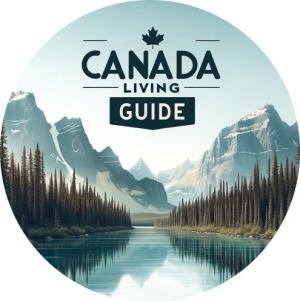38 Remarkable Things Canada is Known For
Let’s take a simple yet wonderful journey through 38 things Canada is known for.
Imagine a place where majestic mountains meet lively cities, where you can taste the sweetness of maple syrup and feel the excitement of a hockey game.
Canada is a land of friendly people, beautiful nature, and a rich mix of cultures. From the quiet beauty of its forests and lakes to the vibrant streets of its multicultural cities, each part of Canada tells its own special story.

This journey is about exploring all those things that make Canada unique and beloved, like a warm, welcoming home filled with a variety of experiences and smiles.
List of 38 Things Canada is Known For
- Snow and Cold Weather
- Natural Beauty
- Canada’s National Parks
- Wildlife
- Niagara Falls
- The Canadian Rockies
- Banff National Park
- The Northern Lights
- The CN Tower
- The Trans-Canada Highway
- Mounties
- The Bay (Hudson’s Bay Company)
- Maple Syrup
- Ice Wine
- Beavertails
- Poutine
- Tim Hortons
- Canadian Bacon
- Butter Tarts
- Nanaimo Bars
- Montreal-style Bagels
- Canadian Club Whisky
- Canola Oil
- The Inuit
- Hockey
- Canoeing
- Terry Fox
- Curling
- Lacrosse
- Canadian Geese
- Polar Bears
- Moose
- Toque
- Toronto International Film Festival (TIFF)
- The Calgary Stampede
- Montreal Jazz Festival
- Multiculturalism
- Politeness and Friendliness
Snow and Cold Weather
Canada is well-known for its cold weather and snowy winters, particularly in the northern regions and the prairies. The winter season brings challenges like snow removal and keeping warm, but it also offers opportunities for activities like skiing, snowboarding, snowshoeing, and ice skating. Canadian cities are well-equipped to handle heavy snowfall, and the winter landscape is often celebrated in Canadian culture and art.
Natural Beauty
Canada is renowned for its vast and diverse landscapes, encompassing both the Atlantic and Pacific coasts, mountain ranges, the Great Lakes, Niagara Falls, and the Arctic regions. These natural wonders are often the first things that come to mind when thinking about what Canada is known for.
Canada’s national parks
Canada’s national parks, known for their stunning beauty and conservation efforts such as Banff and Jasper in the Rocky Mountains, are globally celebrated as prime examples of what Canada is known for.
Wildlife
Canada is committed to wildlife conservation, protecting its diverse ecosystems and the species that inhabit them, like the grizzly bear, caribou, and orca. National parks, wildlife reserves, and conservation programs play a crucial role in preserving Canada’s natural heritage. These efforts are essential for maintaining biodiversity and ecological balance in the country’s vast and varied landscapes.
Niagara Falls
Niagara Falls, an iconic natural wonder and a prime representation of what Canada is known for, offers a breathtaking spectacle of awe-inspiring power and beauty. Straddling the border of Ontario and New York, these magnificent falls comprise three distinct cascades: the Horseshoe Falls, American Falls, and Bridal Veil Falls. The astounding volume of water cascading over the cliffs, particularly at Horseshoe Falls, captivates visitors from around the world with its mesmerizing force.
The Canadian Rockies
The Canadian Rockies are a major mountain range stretching across British Columbia and Alberta. Renowned for their stunning scenery, they offer a paradise for outdoor enthusiasts, including opportunities for hiking, skiing, and mountain biking. National parks like Banff and Jasper are popular destinations, attracting millions of visitors annually with their pristine lakes, diverse wildlife, and breathtaking landscapes.
Banff National Park
Banff National Park, located in Alberta’s Rocky Mountains, is Canada’s first national park and a UNESCO World Heritage Site. Known for its stunning alpine landscapes, turquoise lakes like Lake Louise, and diverse wildlife, it’s a year-round destination for outdoor activities such as hiking, skiing, and wildlife watching.
The Northern Lights
The Northern Lights, or Aurora Borealis, is a natural light display best viewed in Canada’s northern regions, like Yukon, Northwest Territories, and Nunavut. These spectacular lights are caused by the interaction of solar particles with the Earth’s magnetic field, creating vibrant colors that illuminate the night sky. Witnessing the Northern Lights is a magical experience and a highlight for many visitors and residents alike.
The CN Tower
The CN Tower in Toronto was the world’s tallest free-standing structure for over three decades. It’s not only a significant architectural feat but also a symbol of Canada’s industrial and technological advancement. The tower offers breathtaking views of the city and, with its revolving restaurant and glass floor, is a must-visit attraction for tourists.
The Trans-Canada Highway
The Trans-Canada Highway is one of the world’s longest national highways, stretching over 7,800 kilometers from the Atlantic to the Pacific. It’s a vital transportation route that connects ten provinces, showcasing Canada’s diverse landscapes and serving as a symbol of national unity and mobility.
Mounties
The Royal Canadian Mounted Police (RCMP), known as the Mounties, represent an iconic aspect of what Canada is known for. As Canada’s federal and national police service, they are recognized worldwide for their distinctive red serge uniforms and Stetson hats, which have become symbols of Canadian law, order, and tradition. The RCMP plays a crucial role in maintaining peace and security across the nation and is also involved in community programs and cultural events.
The Bay (Hudson’s Bay Company)
The Hudson’s Bay Company is North America’s oldest company, founded in 1670. Initially a fur trading business, it has evolved into a major retail group, with its flagship department store, The Bay, being a staple in Canadian shopping. The company’s iconic point blanket is a symbol of Canadian heritage and history.
Maple Syrup
Maple syrup, a quintessential symbol of what Canada is known for, is celebrated for its natural sweetness and deep-rooted place in Canadian culinary traditions. Sourced from the sap of sugar maple trees, predominantly in Quebec, this syrup is a staple in kitchens across Canada. It’s a versatile ingredient, enhancing everything from classic pancakes and waffles to inventive dishes like maple-glazed salmon. The traditional process of extracting sap and transforming it into syrup, known as sugaring off, is a beloved springtime ritual in many Canadian regions.
Ice Wine
Canada, particularly Ontario, is renowned for its ice wine, a type of dessert wine produced from grapes that have frozen naturally on the vine. The freezing process concentrates the sugars and acids, resulting in a sweet, rich flavor. Ice wine is a luxurious product, often enjoyed on special occasions or as a dessert accompaniment.
Beavertails
Beavertails are a famous Canadian pastry, particularly popular in winter and at outdoor events. They are made from fried dough stretched to resemble a beaver’s tail, topped with various sweet toppings like cinnamon sugar, chocolate, or fruit. Originating in Ottawa, these pastries have become a staple at Canadian fairs and festivals.
Poutine
Poutine is a beloved Canadian dish originating from Quebec in the 1950s. It consists of French fries topped with cheese curds and smothered in a rich, brown gravy. The combination of textures and flavors makes poutine a comfort food favorite across Canada. It has also inspired various gourmet variations, incorporating ingredients like pulled pork, lobster, or vegetarian gravy.
Tim Hortons
Tim Hortons is a Canadian coffee chain, fondly referred to as “Tim’s” by locals. Founded in 1964 by Canadian hockey player Tim Horton, it has become a staple in Canadian culture, known for its coffee, doughnuts, and Timbits (bite-sized doughnut holes). Its presence in almost every town and city makes it a popular meeting spot and a symbol of everyday Canadian life.
Canadian Bacon
Canadian bacon, or peameal bacon, is a type of back bacon made from lean, boneless pork loin. Traditionally rolled in cornmeal, it is known for its tender texture and sweet flavor. Different from the streaky bacon commonly found in the United States, Canadian bacon is a popular breakfast item and is also used in various recipes.
Butter Tarts
Butter tarts are a quintessential Canadian dessert, consisting of a flaky pastry shell filled with a buttery, sugary, and sometimes nutty filling. Their exact origin within Canada is debated, but they remain a favorite at bakeries and kitchen tables across the country. Butter tarts are a simple yet indulgent treat, embodying the comfort of Canadian home baking.
Nanaimo Bars
Nanaimo Bars are a no-bake dessert named after the city of Nanaimo in British Columbia. They consist of three layers: a crumbly, nutty base, a creamy custard-flavored middle layer, and a smooth chocolate topping. This sweet treat is a Canadian classic and has become a beloved dessert in households and bakeries across the country.
Montreal-style Bagels
These bagels are smaller, denser, and sweeter than their New York counterparts, often baked in wood-fired ovens.
Canadian Club Whisky
One of the most well-known Canadian whisky brands recognized globally.
Canola Oil
Canada is one of the largest producers of canola oil, known for its light flavor and health benefits.
The Inuit
The Inuit are Indigenous peoples residing in Canada’s Arctic regions. They have a rich cultural heritage and deep-rooted traditions that are closely tied to the harsh Arctic environment. The Inuit contribute significantly to Canada’s cultural diversity, and their art, language, and way of life are an integral part of the nation’s identity.
Hockey
Hockey, more than just a sport, forms a crucial part of Canada’s national identity and is another great example of what Canada is known for. Renowned for cultivating some of the world’s most skilled players, Canadian hockey is a blend of intense passion and exceptional talent. The National Hockey League (NHL), with its numerous Canadian teams, garners avid following from fans across the nation. In Canada, children often grow up playing hockey on outdoor rinks, and community games are a beloved and familiar sight throughout the winter months.
Canoeing
Canoeing is a cherished activity in Canada, reflecting the country’s rich history and connection with its vast waterways. Canoes were essential for the Indigenous peoples and early settlers for transportation and trade. Today, canoeing is a popular recreational activity, offering a peaceful way to explore Canada’s lakes, rivers, and national parks.
Terry Fox
Terry Fox is a Canadian icon and hero, known for his Marathon of Hope in 1980, an attempt to run across Canada to raise money and awareness for cancer research. Despite losing his leg to cancer, Fox ran an average of 42 kilometers a day for 143 days. Although he was forced to stop as his cancer spread, his legacy lives on. The Terry Fox Run, held annually, has become one of the largest fundraising events for cancer research in the world, symbolizing hope, determination, and the spirit of giving.
Curling
Curling is a significant winter sport in Canada, involving teams sliding stones on a sheet of ice towards a target area. This strategic and skillful game is often referred to as “chess on ice.” Curling clubs are common across the country, and the sport is an integral part of Canadian culture, with Canada being highly successful in international curling competitions.
Lacrosse
Lacrosse, originally played by Indigenous peoples, was declared Canada’s national summer sport in 1994. It is a fast-paced, contact team sport played with a small rubber ball and a long-handled stick called a crosse. The sport has deep cultural significance and has evolved into a popular activity at the amateur and professional levels in Canada.
Canadian Geese
The Canada goose is a familiar sight in many parts of the country. Known for their distinctive V-shaped flying pattern and honking sound, these geese are a symbol of the Canadian wilderness. They are also noted for their seasonal migrations, a natural spectacle observed in the spring and fall.
Polar Bears
Churchill, Manitoba, is renowned as the Polar Bear Capital of the World. Every fall, polar bears migrate towards the coast of Hudson Bay, passing through Churchill, providing unique opportunities for wildlife viewing. The town has specialized in eco-tourism, offering guided tours in tundra buggies to observe these magnificent creatures in their natural habitat.
Moose
The moose is one of Canada’s most iconic and largest wild animals, symbolizing the vast and wild nature of the country. These majestic creatures are found across Canada’s forests and national parks. Their impressive size and distinctive features, such as the male’s large antlers, make them a symbol of Canadian wildlife and a popular subject in Canadian art and folklore.
Toque
A toque is a knitted cap, often worn during Canada’s cold winters. It’s a part of Canada’s national winter attire, known for its practicality and variety of styles. The toque has become a fashion statement and a staple in Canadian wardrobes, often sporting hockey team logos, maple leaves, or other distinctly Canadian symbols.
Toronto International Film Festival (TIFF)
The Toronto International Film Festival is one of the most influential film festivals globally. Held annually in Toronto, it attracts filmmakers, celebrities, and movie enthusiasts from all over the world. TIFF serves as a launchpad for new films and a showcase of international cinematic achievements, enhancing Canada’s profile in the global film industry.
The Calgary Stampede
Known as “The Greatest Outdoor Show on Earth,” the Calgary Stampede is an annual rodeo, exhibition, and festival held in Calgary, Alberta. Celebrating Western heritage and community spirit, the event features rodeo competitions, concerts, parades, and agricultural exhibits. It’s a major tourist attraction and a proud tradition for many Albertans and Canadians.
Montreal Jazz Festival
The Montreal International Jazz Festival is one of the largest jazz festivals in the world. Held annually in Montreal, Quebec, it attracts thousands of artists and hundreds of thousands of spectators from around the globe. The festival showcases a wide range of jazz styles and includes both free outdoor performances and ticketed events, contributing significantly to Montreal’s vibrant cultural scene.
Multiculturalism
Multiculturalism in Canada is a fundamental characteristic of the national identity. Officially adopted as a policy in 1971, it encourages the preservation and sharing of cultural heritage and values. This policy has shaped Canada into a mosaic of cultures, making cities like Toronto and Vancouver among the most diverse in the world.
Politeness and Affability
Canadians are stereotypically known for being exceptionally polite and friendly. This reputation for good manners and a welcoming nature is a common international perception.
Related Articles
-

Moving to Toronto
Moving to Toronto is an exciting choice, as Canada’s largest and most diverse city offers a lot. People move to… Read more
-

The Essence of Canada: A Guide to Typical Canadian Dishes
Typical Canadian dishes, showcased in this food guide, reflect the country’s extensive and diverse landscape. This makes exploring Canadian culinary… Read more
-

How to Save for University in Canada with RESPs
If you want to know how to save for university in Canada with RESPs, you’ve come to the right place.… Read more







